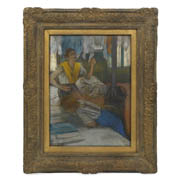Details
- Object type
pastel
- Title
Laundresses
- Artist/Maker
- Culture/School
French
- Place Associated
Paris, France (place made)
- Date
circa 1882-1884
- Materials
pastel on paper
- Dimensions
framed: 890 mm x 730 mm x 90 mm; unframed: 635 mm x 457 mm
- Description
-
Although Degas was from a privileged background, he devoted a large part of his career to the depiction of the working women of Paris – dancers, milliners, prostitutes and laundresses. He does not idealise these women – he paints them in a realistic way. He scrupulously records their every gesture and their surroundings.
Against a backdrop of a dark room, lit by tall windows, Degas shows the various steps involved in the operation of a laundry. On the floor lies a bundle of soiled clothes, while the wet washing hangs above, on a line, to dry. On the right is the special stove where the irons are heating – with the stovepipe stretching on up and out of the picture – and on the left we see a row of newly pressed shirts laid out along the large ironing counter.
Degas first tackled the theme of the laundress in 1869 and would continue to work on it over a twenty-year period. Unlike his many pictures of ballet dancers, racehorses or nudes, there are only about 10 finished paintings and pastels and a similar number of studies on the subject. However, we know Degas regarded them highly, for eight were included in the Impressionist exhibitions held in 1874, 1876, 1879 and 1881.
For Degas the laundress was a symbol of modern urban woman, the true Parisienne. During a visit to his family in New Orleans in 1872, one of his letters home reveals his feelings: ‘Everything is beautiful in this world of the people. But one Paris laundry girl, with bare arms, is worth it all for such a pronounced Parisian as I am.’
Despite the harshness of the subject Degas was able to sell his works of laundresses relatively easily - possibly because the laundress was a familiar figure in the literature and popular imagery of Degas’s day. The Goncourt brothers wrote novels around the lives of housemaids and prostitutes - an example is Germinie Lacerteux (1865); and life in the laundry plays a central role in Zola’s novel L’Assommoir (1877).
In an entry in his Journal, of 13 February 1874, the writer Edmond de Goncourt recorded :‘Yesterday I spent the day in the studio of a strange painter called Degas. After a great many essays and experiments and trial shots in all directions, he has fallen in love with modern life, and out of all the subjects in modern life he has chosen washerwomen and ballet-dancers.’
He continued: ’When you come to think of it, it is not a bad choice... He showed me, in their various poses and their graceful foreshortening, washerwomen and still more washerwomen... speaking their language and explaining the technicalities of the different movements in pressing and ironing.’
Degas rarely gave his works titles. The titles we use today are often those applied to the works by dealers, critics, or by previous owners. When William Burrell purchased this pastel from the Parisian dealer Georges Bernheim, in May 1927, it was known as ‘La lecture de la lettre’ - ‘Reading the Letter’. Is this an appropriate title?
Certainly the seated figure, holding a sheet of paper in her left hand, could be interpreted as reading a letter. Some commentators have even searched, unsuccessfully, for a similar scene in the novels of Zola and the de Goncourt brothers because, unusually for Degas, he includes a specific detail – she wears a gold ring on the fourth finger of her right hand. What is she doing? Her head up and back, her mouth wide open, she is probably shouting out a laundry list – confirming the laundry they have just finished, or itemising what they have to do next.
- Credit Line/Donor
Gifted by Sir William and Lady Burrell to the City of Glasgow, 1944
- Collection
Burrell Collection: Pictures [Oils, Pastels and Watercolours]
- ID Number
35.244
- Location
In storage


